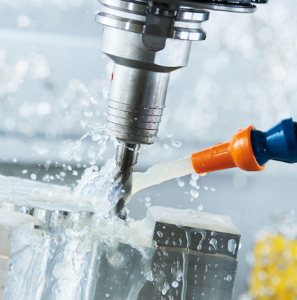In the dynamic world of manufacturing and industrial settings, the use of metalworking fluids (WMMFs) is integral to various processes. These fluids aid in lubrication, cooling, and chip removal during machining operations. However, concerns have arisen about the potential health risks associated with traditional oil based Metal working fluids. In response, many industries are shifting towards Metal working fluids as a safer alternative. This blog delves into the advantages of metal working fluids and their connection to workplace air monitoring, ensuring a healthier atmosphere for employees.

Metalworking Fluids:
A Safer Choice WMMFs, as the name suggests, are a combination of water and various additives such as lubricants and corrosion inhibitors. This mixture offers several advantages over traditional oil-based counterparts, including:
Health and Safety: WMMFs typically have lower concentrations of volatile compounds, reducing the potential for harmful emissions into the air. This makes them a safer choice for workers who could have exposure to WMMF aerosols during machining operations.
Environmental Impact: Metal working fluids are generally more environmentally friendly due to their reduced content of oil-based components. This minimizes the impact on soil and water sources, contributing to sustainable manufacturing practices.
Cost-Effectiveness: WMMFs are often more cost-effective than their oil-based counterparts. With improved efficiency and longer tool life, businesses can benefit from reduced operational costs.
Workplace Air Monitoring and Metal Working Fluids:
While WMMFs offer significant advantages in terms of health and environmental impact, it is crucial to monitor workplace air quality to ensure that potential risks are effectively mitigated. Here’s how workplace air monitoring plays a pivotal role in the context of Metal working fluids:
Aerosol Emission Monitoring:
Why it matters: During machining processes, metal working fluids can generate aerosols that may contain contaminants.
How to monitor: Use a direct reading aerosol monitor (DRAM) to measure the concentration of airborne particles to ensure it is as low as reasonably practicable (ALARP) at the operator position.
Alternatively personal or static samples can be taken in line with MDHS 95/3 Measurement of personal exposure of metalworking machine operators to airborne water-mix metalworking fluid. To use this method, the WMMF must contain one of three markers, but it should be noted that there is no UK Workplace Exposure Limit and exposures should be ALARP.
VOC Monitoring:
Why it matters: While metal working fluids have lower VOC content compared to oil-based alternatives, monitoring is essential to confirm compliance with regulatory standards.
How to monitor: Generally active sampling is undertaken to measure the concentrations of Volatile Organic Compounds in the air. Personal exposures can then be compared to Workplace Exposure Limits to ensure levels are adequately controlled.
Humidity Control:
Why it matters: Excessive humidity in the workplace can lead to the growth of mould and bacteria in WMMFs, potentially causing respiratory issues.
How to monitor: Use humidity sensors to maintain optimal levels and prevent the accumulation of moisture in the air.
Employee Feedback:
Why it matters: Employees are the frontline observers of workplace conditions. Encouraging them to report any unusual Odours or health symptoms can help identify potential issues with WMMFs.
How to monitor: Establish a feedback system and regularly communicate with employees to address concerns promptly.
Health risks to metal working fluids
Exposure to metalworking fluids can pose health risks if not managed effectively. Inhalation of MWF aerosols may lead to respiratory issues, irritation of the eyes, nose, and throat, and in some cases, skin disorders. Prolonged exposure may even contribute to more severe conditions such as occupational asthma. To mitigate these risks, it is crucial to implement preventive measures:
- Engineering Controls: Utilise effective ventilation systems to capture and remove airborne contaminants at the source. You could also, measure settlement times within enclosure to ensure they are only open when it is safe.
- Personal Protective Equipment (PPE): Provide workers with appropriate PPE, including respiratory protection, goggles, and gloves, to minimise direct contact and inhalation.
- Training and Education: Ensure that employees are well-informed about the potential hazards of metal working fluids and are trained in proper handling, storage, and disposal procedures.
Regular Monitoring: Implement routine workplace air monitoring to promptly identify any deviations from acceptable air quality standards. This allows for timely corrective actions.
Final Thoughts
By combining these measures, businesses can create a safer working environment. This ensures that the advantages of metal working fluids can control itself without being compromising the health and well-being of their workforce.
The adoption of water-mix metal working fluids represents a positive shift towards safer and more sustainable manufacturing practices. However, the responsibility doesn’t end with the switch; regular workplace air monitoring is essential to ensure that the benefits of WMMFs are at there max while potential risks are lowest. By prioritising the health and well-being of employees and maintaining a vigilant approach to air quality, industries can strike the right balance between efficient manufacturing processes and a safe working environment.
Synergy Environmental Solutions provide sampling and consultancy services throughout the UK and Ireland. We’re happy answer any questions you may have, or provide you with a obligation free estimate for your work. Visit the contact page or contact us on the details below:


